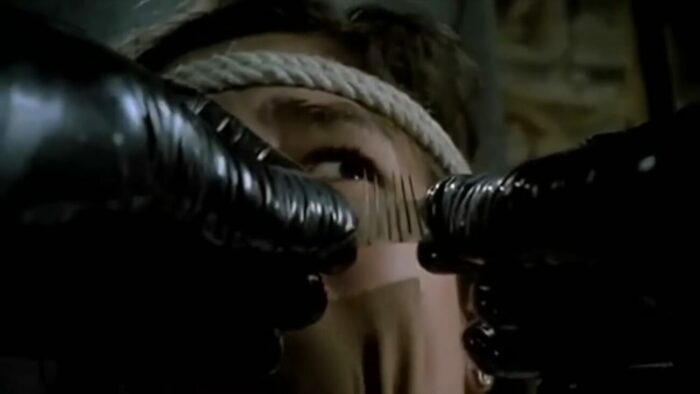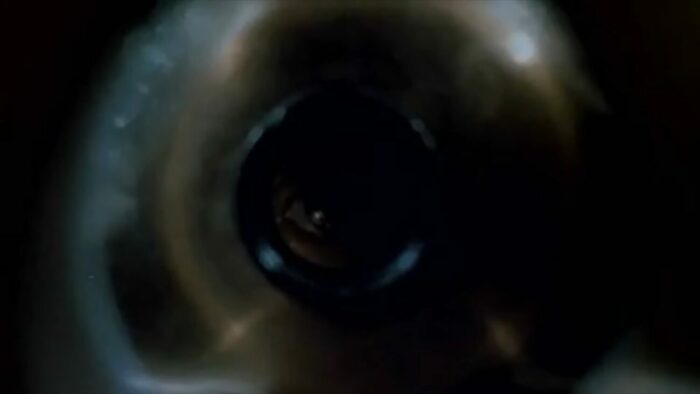Being so prolific in a certain subgenre comes with its ups and downs. A positive of that means you get to work through the years to perfectly craft and mold the tropes, fully understanding what works, and what doesn’t. The major downside of that is you can’t let audiences know your next move, you have to find new and intriguing ways to startle your audience. Most importantly, you have to realize just because you’ve earned status and respect doesn’t mean the audience will just accept what you give them.

One of the last Dario Argento films that was on my list was his ’87 opus Opera. The only reason it took so long to get to it was its menacingly macabre cover art. As someone who can’t do eye stuff, both in film and life, just thinking about the cover was enough to make me weak in the knees. So I thought, with the advent of Slasher Saturdays, why don’t I finally watch it? Slumber Party Massacre II and House of Wax were repeat views for me, so I knew more or less what I wanted to say about them. When I decided to cover Opera I was a bit hesitant. As stated many times before, I love giallo films, but the subgenre is far from my area of expertise. After watching it, I was a bit upset it took me so long to watch it.
Opera follows the story of understudy Betty (Cristina Marsillach), who, after the unfortunate accident of veteran opera singer Mara Czekova, gets called to the big stage. Betty must headline the opera of Macbeth for filmmaker turned stage director Marco (Ian Charleson). When the people closest to Betty start getting murdered left and right, while she is forced to watch, she must do anything necessary to survive. Will Betty live to see tomorrow? Or will tonight’s performance of Macbeth be her final curtain call?
Visually, Opera is one of Dario Argento’s most visually intriguing films. There are three main aspects Opera visually succeeds in setting, kills, and cinematography. Setting-wise, Opera rivals Suspiria for the most interesting setting. Stepping out of the bleak halls of Tanz Akademie and thrusting us into the magnificent and grandiose Teatro Regio. Opera halls usually look fairly warm and welcoming, while the Teatro Regio feels more brooding and intimidating. From the washed-out yellows of the walls surrounding the opera boxes to the cramped backstage with a throng of stagehands frantically trying to hit their marks, there is not a moment inside of the theater that feels sane or peaceful. Less interesting are the sets outside of the theater, but Betty’s apartment does bring a sort of tranquil energy to this high-strung slaughterfest.

Secondly, visual-wise, we have the kills. And it’s really not just the kills that are visually stunning, it’s what happens to Betty during the kills. It’s been widely reported that Argento and Cristina Marsillach had a less than cordial relationship during the filming of Opera. Now it’s not too clear as to what the quarrels consisted of, but after viewing this film, I think I can pinpoint some…ideas. First, whenever the killer grabs Betty he forcefully pulls her by her hair, and once by her hair and ear, in a way that feels wholly unsafe—not unsafe in the sense of it being transgressive but rather in the sense of it looks beyond painful. The other idea I have for the possible tense relation is—oh, I don’t know—how she had to wear needles under her eyes TAKE AFTER TAKE! The prolific cover image gives away the big moment(s) of the film, though it does not take away from the truly disturbing scenes it is featured in. So it makes sense how Marsillach might not have had the best time while filming this.
Getting back to the kills, we find a sort of restrained, albeit impactful, Argento in action. The kills may not be the most imaginative for an Argento film, but they still have power and anger behind them. When the killer stabs Stefano (William McNamara) multiple times, I had to go back and rewatch the scene because there are a few stabs where it actually looks like McNamara is being impaled. Funnily enough, the most shocking kill is the least bloody of them all. Betty’s agent Mira (Daria Nicolodi) comes over to her apartment so that Betty can finally fill her in on the events that have been transpiring. When they start to question if Betty’s security detail is actually a cop or if he is the killer we find ourselves in a tense scenario bathed in darkness. Mira is conversing through the front door’s peephole to see who is on the other side. That’s when the killer raises a revolver to the peephole and blows Mira’s brains out. What made it feel really unexpected is how it seemed too easy for Argento, even though you could kind of see it coming from a mile away. Nicolodi, after a breakup with Argento, only agreed to do this role because she, too, thought the kill was brilliantly shocking.
The third aspect that makes Opera stand out visually among the rest of Argento’s films is the cinematography. Cinematographer Ronnie Taylor and director Dario Argento are a force to be reckoned with. Taylor uses his expertise to take the Teatro Regio and make it into a menacing character, looming over our actors with washed-out deadly eyes. Even the blander scenes within Betty’s apartment are still filmed with grace, acting as a sort of buffer from the onslaught of gore and viscera. If there was one thing this film was known for, aside from the needles, it would be the crow camera. Having live crows on stage for a theatrical performance is without a doubt a hardcore flex by Marco. During the climax they release the crows in an attempt to have them single out the killer, this is a callback to when the crow wrangler makes a statement about how exceptionally smart crows are. Once released, a singular crow flies throughout the audience, and that’s when the camera takes its point of view. Circling high above the audience, we join the crow on its adventure to find and single out the one man responsible for all of this death. This shot is hands-down one of the most technically beautiful shots in any Argento film.

I would also be remiss to not bring up the soundtrack. While it is not credited as having a soundtrack by Goblin, the sweet melodic tones brashly shift into hard rock at a moment’s notice. It should be noted that one of the composers of Opera is Claudio Simonetti, keyboardist for Goblin. Every time you hear the soundtrack switch from dulcet tones to heavy guitars and drums, you feel this level of excitement and terror. You know that this music shift means someone’s life is about to end in an unfortunate way.
Opera was truly a one-of-a-kind film; it doesn’t pull any punches. Bloody, loud, and reckless, Opera is a brash reflection on Argento by Argento. I’m glad I finally checked this one off my list, and I will definitely be going back to this one. What’s most interesting about Opera is how it feels both transgressive and restrained. The scenes of horror are horrific, and the scenes of calm are tranquil. I’ve seen some people label Opera as Argento’s last great film, and if that’s true, then this was one hell of a film to end a streak on.




